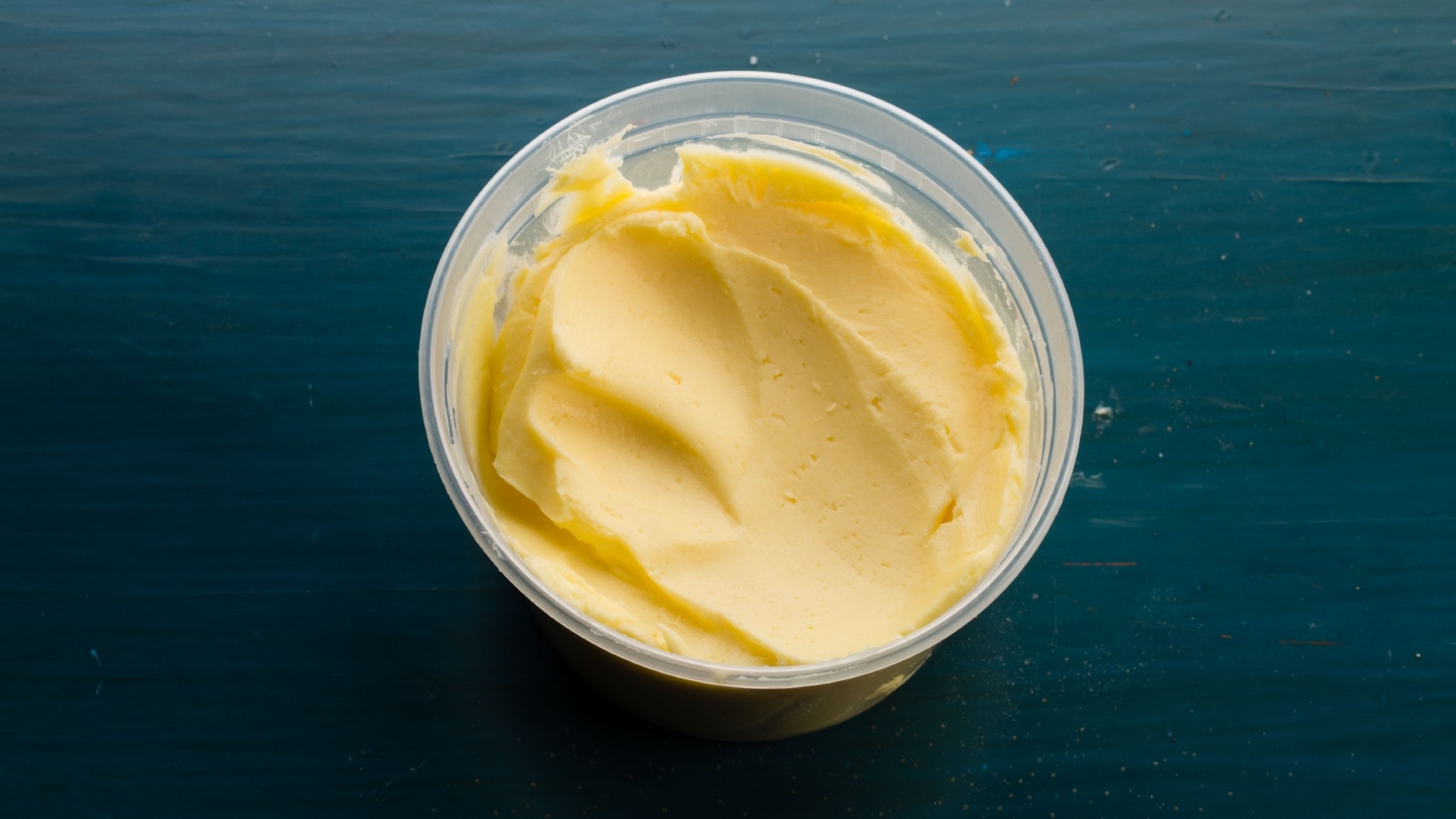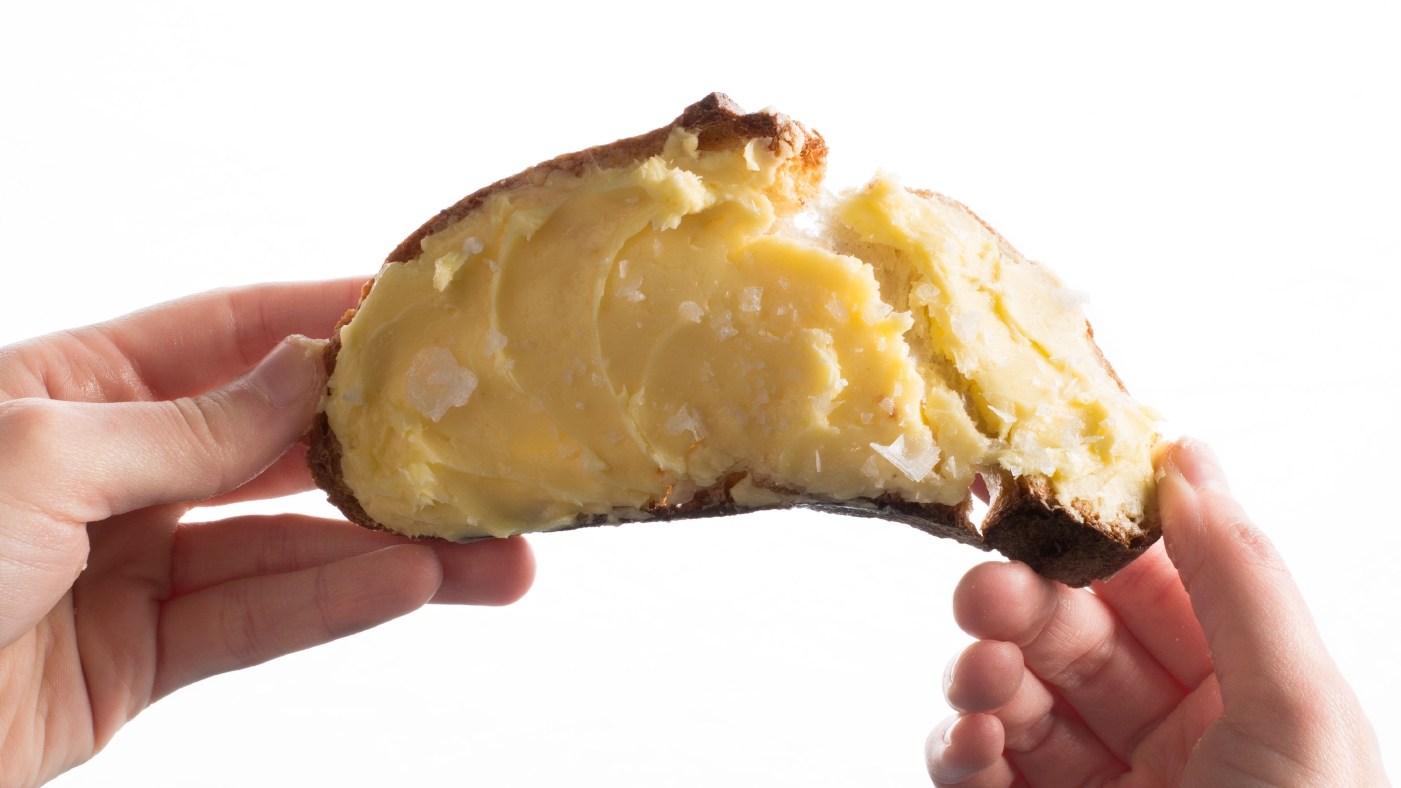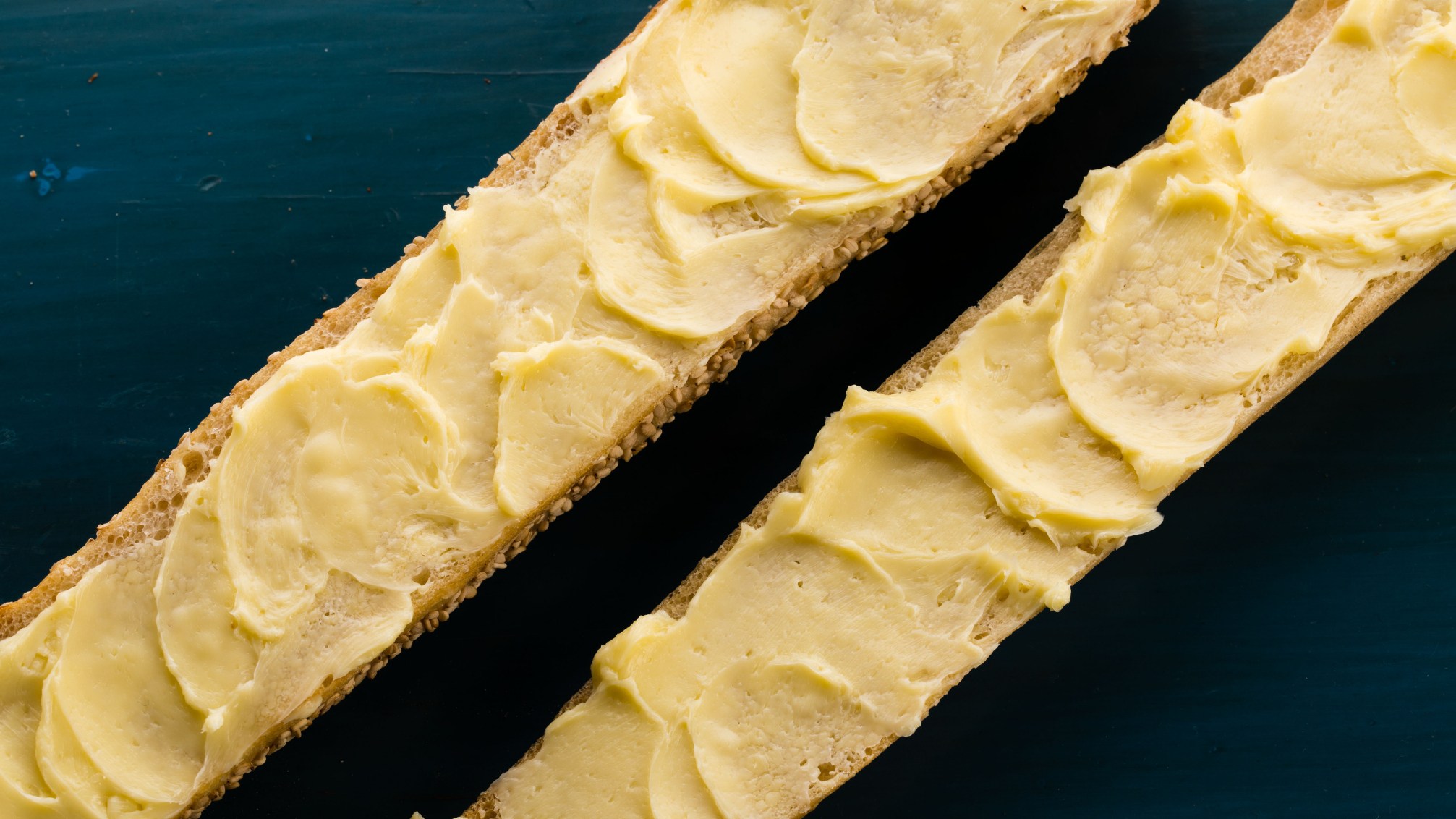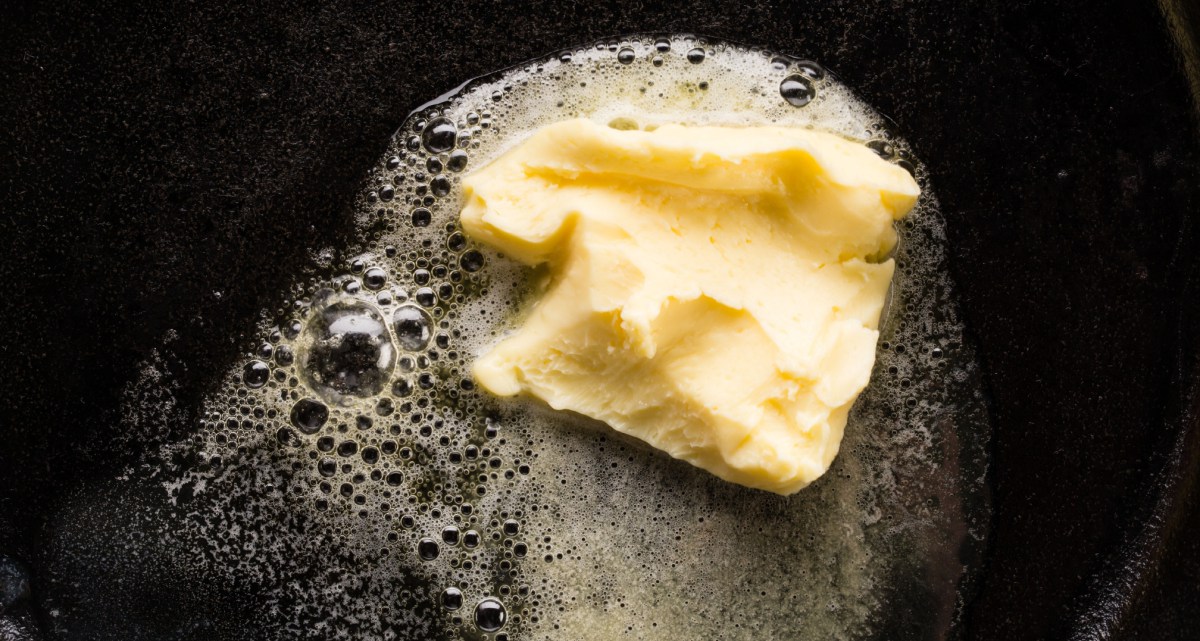All cooking is magical, but the transformation of cream into butter has a simplicity and suddenness that sets it apart. For this domestic miracle, beat and beat cool cream until it whips up into a delicate foam—and then keep going. At the very moment that it starts to seem like nothing is ever going to happen, brilliant yellow specks appear amid the white. Quickly the specks aggregate into grains, then kernels, then a stiff mass of solid yellow splashing in thin pale liquid. The butter has come.
That’s how butter was made for centuries, and that’s how Vermont farmer Diane St. Clair makes Animal Farm butter, which aficionados buy for $50 a pound. I visited St. Clair on a cold day in December to learn about how she makes butter, why her product tastes so good, and whether I could come close to her results at home.
Twice a day, St. Clair milks her herd of nine Jersey cows. As the fresh milk sits and cools over a span of hours, a layer of cream rises to the top. She skims the cream off, lets it rest, runs it through a pasteurizer at 150°F (65°C), then adds a little of her own buttermilk and lets it sit another day. The low-fat milk left behind gets fed to the calves.
Live bacteria from the buttermilk start to work in the cream, fermenting some of the lactose sugar into lactic acid, which gives it a distinctive tanginess and also thickens it slightly. After a day, the cultured cream is ready to go into the churn. The Animal Farm churn is a rotating drum, sort of like a clothes dryer, that lifts the cream and lets it drop, over and over, until it becomes butter. Churning a batch of cream can take an hour, but it all depends on the cream.
“In the winter, when they’re eating hay, churning takes longer. In the summer, especially as the grass gets lusher, the butter is fragile and it’s easy to overchurn. Overchurned butter is greasy.”
When the churning is done, St. Clair brings the mound of butter over to a work surface, where she washes off some of the remaining milk solids and kneads it by hand, squeezing out as much moisture as she can. When she deems the texture right, the butter is ready to wrap and sell.

HOW BUTTER HAPPENS
Milk is an oil-in-water emulsion. It’s almost 90 percent water, with dissolved sugars and proteins, and globules of milk fat, each just a few microns across, dispersed throughout. A complex membrane with emulsifying properties encloses each globule. The membrane acts as an interface between the fat and the water, keeping the fat particles separate and suspended. Although the fat particles gradually rise to the top as cream unless the milk is homogenized, the membrane helps them stay at least somewhat suspended in the emulsion instead of becoming an oil slick.
Straight out of the cow, the average milk contains 4 percent fat, though this number varies significantly with what the cow’s been eating and the breed. The Jersey herd that St. Clair has deliberately bred for high fat production can achieve a luxurious 8 percent.
Fat floats on water because it’s less dense, and despite the membranes, over time some of the fat suspended in a container of fresh milk will rise to the top. As a result, after a day or so of sitting undisturbed, the topmost layer of the milk will consist of 35 percent or more fat. This rich top layer is the cream, which is traditionally skimmed off and used by the butter maker.
Cream, like milk, is an oil-in-water emulsion, but a much richer one—the fat particles swimming in the water phase make up 35 to 40 percent of the weight of the cream, rather than just 4 percent in milk. Churning cream into butter basically involves beating air into the cream and slamming the fat particles against each other again and again. On a microscopic level, tiny air bubbles worked into the cream act like magnets for fat. Each air bubble will stick to several fat particles and disrupt their protective membranes, causing the fat to cling to the surface of the bubble. When two air bubbles collide, the fatty layers that surround them merge, creating a larger clump of solid fat. And clump sticks to clump, snowballing until almost all the fat is stuck together in a big mass, and the liquid—the buttermilk—is fat-free.
The mass of fat still contains plenty of liquid, so the final step, after draining it, is to “work” the butter. Traditionalists like St. Clair slowly knead it by hand. At Ronnybrook, a dairy farm in upstate New York, the two women who make butter daily keep spinning the churn for a time after the buttermilk is drained off. Both of these methods have the same effect: squeezing moisture out of the mass of butterfat.
This extra working of the butter accomplishes the ultimate goal of butter making: inverting the emulsion.
What does that mean? As the fat particles coalesce during the kneading phase and moisture is forced out of the spaces between them, the nature of the substance transforms. It changes from an oil-in-water emulsion, where water is the dominant element and fat is dispersed throughout it, to a water-in-oil emulsion. The united butterfat forms a continuous mass, and microscopic pockets of moisture—around 15 percent of butter is water—are scattered throughout it. The network of solid crystalline fat gives butter its firm structure, holding the water in place. As soon as a piece of butter melts, the moisture escapes from its delicate dispersion among the pockets. If it solidifies again after melting, it’s no longer an emulsion. It’s no longer butter, just butterfat.

WHAT MAKES GREAT BUTTER?
Almost all the butter Animal Farm makes is bought by Thomas Keller to serve in his top-flight restaurants, the French Laundry and Per Se. Each year, a small amount is sold to the public via New York’s Saxelby Cheesemongers, where it’s snapped up fast—even at premium price. And understandably: Each little knob of the stuff is radiantly yellow and delicately fragrant. Spread on bread, it’s cool, rich, and unusually complex in flavor, with a lingering nutty nuance.
The butter from New York’s Ronnybrook Farm, which doesn’t go through the culturing step, is delicious in a different way—paler and firmer, with a clean, milky taste that remains on the palate for minutes on end. What makes these butters so different from each other, and so much better than the sticks you get in the supermarket?
Cream
“Especially for sweet cream butter [that is, butter that’s not cultured], you want the cream to be as fresh as possible,” says food scholar and author Harold McGee. As cream spends time outside the cow, it undergoes a number of changes. Tiny air bubbles that get into the milk during processing and transportation, as well as changes in temperature, disrupt some of the fat. globules and make them clump. Enzymes, both those naturally present in milk and those created by bacteria that grow at low temperatures, start to break down some of the milk fat, which can cause subtle off-flavors, as can the presence of oxygen.
And these changes are magnified when cream is concentrated into butter.
Much of the lush nuance of farmstead butter is due not just to the cows’ excellent diets of grasses and flowers, but to the seasonal variability of those diets. “In late summer, with lusher grass and more flowers, there’s more intense flavor, and the texture is much more spreadable,” says St. Clair. The hay the Animal Farm cows eat in the winter is no less carefully assembled: “clover, second-cut grasses, trefoil—and terroir. If I fed a herd the same things in California, the butter would taste completely different.”
When cows are raised on a fixed diet, the cream tastes the same year-round. And a lot of consumers, and therefore producers, prize this consistency. As a result, even many artisanal butter producers buy cream in bulk from creameries that batch together the output of numerous farms and mechanically separate the cream.
Culture
Historically, culturing wasn’t something you did to make your butter better—it was just what happened. If you were a farmer with a cow or two, it’s likely you needed a few days’ worth of cow’s milk to amass enough cream for a batch of butter. As your bucket of cream sat around, waiting in vain for refrigeration to be invented, wild bacteria naturally found their way into it and soured it a bit.
Nowadays, culturing cream is a careful science. Elaine Khosrova, author of the recent book Butter: A Rich History, showed me how she makes butter in her home kitchen, starting with a powdered culture of freeze-dried bacteria made by Danish biotech company Chr. Hansen. The culture contains a precise mix of four different strains of bacteria. Two strains are primarily responsible for creating lactic acid, which gives a tart flavor and lowers the pH of the cream.
As the cream becomes more acidic, the other two strains start to create new aroma compounds; most importantly diacetyl, which is the molecule responsible for what we think of as buttery flavor. Synthesized diacetyl is added commercially to a wide variety of foods—margarine, microwave popcorn, pancake syrup. In the supermarket, it’s increasingly possible to find cultured butters, but commonly, industrially made butter is not cultured. Instead, it has diacetyl added after the fact, to give it the desired aroma. Diacetyl is also produced during fermentation of wine, especially buttery-tasting Chardonnays, and beer, where it’s usually considered undesirable.
Meanwhile, in the now-acidic cream, some of the strands of protein that make up the fat globules’ membranes slowly split off and knit together into microscopic webs throughout the cream, causing the liquid to thicken. The disruption of the membranes also means there’s more free fat floating around and clumping together.
Apart from the magic of witnessing the process firsthand, the main compelling reasons to make butter at home are if you have access to excellent cream or “a really interesting culture,” says McGee. Store-bought buttermilk—which is mostly made by culturing low-fat milk, not as a by-product of butter making—has the right kind of culture for making homemade butter, so it can be a good starting point.
Only a few butter makers culture longer than 48 hours, but long culturing can produce unique, delicious effects, as the bacteria work their flavorful wonders for days. Grant Harrington of England’s & [Ampersand] Butter lets his cream culture for a full week to make it “as buttery as possible.”
Texture
Elaine Khosrova has traveled the world tasting butters, and she gave me tastes of a selection of butters that varied widely not just in taste but also in consistency. “The aspect I’m most interested in these days is texture,” she says. She cut a long, thin slice from a block of French butter and held it up by one end. It was firm yet smoothly bendable, and its yellow surface was shiny and dry. “There’s a lot of moisture in it, but it’s all tucked away in tiny droplets.” We ate the slice. It was delicious.
The texture of butter is mostly a factor of the solid fat crystals that make up its framework. Nestled within the matrix of crystals are bubbles of water, milk solids (mostly protein and sugar), air, and noncrystallized fat.
The majority of the fat in butter is part of that crystalline network, but fat globules that survive churning intact, still snug in their membranes, don’t link up with the crystals. As a result, they don’t contribute to the butter’s firmness, so all else being equal, the more intact globules are in the butter, the softer it is.
Both St. Clair and Rick Osofsky, president of Ronnybrook, emphasize how gently they treat their cream so as to keep the fat globules intact. St. Clair ladles the cream layer off the milk by hand as it slowly rises, and Osofsky keeps all his milk unhomogenized, so even the bottles of Ronnybrook milk for sale in supermarkets have a layer of cream at the top.
The ratio of harder to softer fatty acids in the cream is also a major contributor to texture. Corn-fed cattle give milk with more palmitic acid, a fatty acid that’s solid at room temperature. A diet of grass leads to much more oleic acid, which is unsaturated, and hence liquid at room temperature. When cows are pastured, as St. Clair points out, the summertime milk tends to have a higher proportion of softer fats. The more of the unsaturated fat that’s present in the cream, the softer the butter will be.
The churning method—fast, slow, how much water comes out—and the way the cream was stored prior to churning, also affect texture.
Robert L. Bradley, professor emeritus at the University of Wisconsin-Madison, notes in his technical butter maker’s manual Better Butter that spreadability of butter out of the refrigerator is a surmountable issue. “Considerable research has focused on ideal spreadability . . . The quick fix is to leave butter at room temperature for 2 hours. Mission accomplished!”
 MAKING IT ON YOUR OWN
MAKING IT ON YOUR OWN
The first homemade butter I ever tasted was a batch my friend made from supermarket cream, without culturing. I was impressed at his enterprising nature and impressed that he could make something just as good as store-bought butter. But, as we realized as the wonder wore off, it wasn’t really any better than store-bought butter. I don’t think he bothered to make it again.
Years later, when I wanted to make butter, I knew that I’d have to go the culturing route. I don’t have a reliable source of particularly good cream in my area and it’s just not practical for me to keep mini apartment cattle—but I do have room for a thriving community of bacteria that can turn ordinary cream into extraordinary butter.
I bought a carton of buttermilk and a few cartons of heavy cream and got to work in my New York apartment kitchen. In playing around with cultures, I tested my homemade yogurt as a starter as well as store-bought buttermilk. Most yogurt cultures don’t include the subspecies of Lactobacillus that specializes in making diacetyl, so creams cultured with yogurt starter instead of buttermilk make intriguing, unexpected butters.
The buttermilk-cultured cream developed a familiar, wonderful flavor that can only be described as buttery, as well as a faint sour tang, both of which got stronger over time. Meanwhile, the culture that started with yogurt developed a sharper, enticing tang but very little buttery flavor—it was a different beast. Out of curiosity, I also tried a batch cultured with a little of each. That one wound up with an interesting rich-and-tart flavor combo, slightly reminiscent of really good cottage cheese. Ultimately I decided on all buttermilk for my recipe.
I also tried using ultra-pasteurized heavy cream, which dominates the shelves at my local markets, instead of regular pasteurized heavy cream, which is slightly harder to find. The ultra-pasteurized product is treated at a higher temperature before it’s packaged, which changes its sugars and proteins somewhat. In my experience, ultra-pasteurized cream takes longer to culture, and the butter it makes has less buttery aroma and a faint but distinct bitter aftertaste.
After 24 hours, the cream sitting out on my counter had thickened and developed a tang. Many butter makers, including St. Clair, stop at this point. Others let it go further, to develop more cultured flavor. I churned and kneaded a batch—remarkably easy!—but it was only slightly tangy and buttery.
Before it’s churned, cream needs to be chilled down below room temperature, to firm up the fat. When I tried churning cream that wasn’t cold enough, it turned into a greasy, mushy mess, with liquid fat mixed into the buttermilk. When I tried saving time by putting cultured cream straight from the fridge into the food processor, it was so thick that it just clung to the sides of the processor bowl, out of reach of the blades. 55°F (12°C) seems to be the sweet spot for churning.
All fats are made up of long chainlike molecules called fatty acids. Milk fat contains a complex mixture of numerous different fatty acids that have different melting points. Because of that mix, butter doesn’t have a single specific temperature at which it melts, like ice does. Instead, it softens gradually as it gets warmer. As we’ve all experienced, butter straight from the fridge is firmish but not rock-solid; as it sits out, it becomes softer but still largely solid.
As cream is held below room temperature, its solid fats lock together in tiny crystal formations. In industrial butter production, carefully manipulating the time and temperatures of cooling affects the nature of these crystals—large, small, uniform, irregular—which influences the final texture of the butter and can compensate for variations in the fatty acid makeup of the cream in different seasons.
After 48 hours of culturing my cream, I made a second batch of butter, and it was more than twice as tasty. It was a full-flavored butter I’d offer to guests. But logically, if longer aging means tastier butter, why stop there?
I let the remaining cream keep culturing, sniffing it every day with a hint of apprehension. It got more and more pungent, but never with that particular “throw it out!” sourness familiar from a neglected refrigerator. After seven days, the aroma was very buttery and also a little cheesy, likely the result of native lipase enzymes in the milk starting to break down some of the milk fat and produce butyric acid, which gives sour milk—and some fine cheeses—their funky odor.
Once this week-old cream was churned, I took a sip of the buttermilk first. It was a lot more acidic than the supermarket stuff I’d started with! But the butter itself was perfect: pliable, tart, rich, and complex, with no off-notes.
Simultaneously, I began working with Dan Souza back at the test kitchen to test a few variables and to get the whole Cook’s Science team to do tastings. We tested a food processor vs. a stand mixer to churn the butter (the food processor won), and figured out the ideal salt content if you want to make a salted version of this butter.
If you want to try your own hand at this deeply flavorful, homemade cultured butter, check out my recipe and go buy yourself some cream.
Photography by Steve Klise.
Food Styling by Elle Simone.

